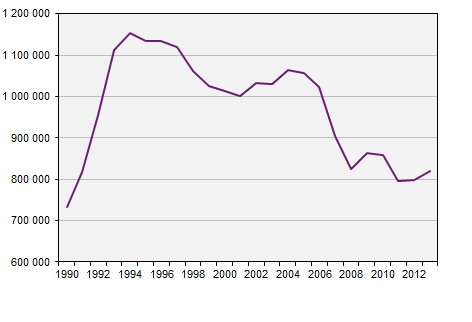Number of full-year persons receiving social assistance and benefits 2013:
More persons receiving economic support
Statistical news from Statistics Sweden 2014-08-13 9.30
nextThe number of full-year persons receiving economic support in the form of social assistance or benefits increased by 2.5 percent 2013 compared to the year before. The number with sickness or activity compensation continued to decrease while the other benefits increased.
Every benefit system is measured in full-year persons, or full-year equivalents. This allows for comparability between the different types of benefits. The term full-year equivalent refers to the number of individuals who can be supported during an entire year on full benefits. For example, two persons who have both been unemployed full-time for six months amount to one full-year equivalent.
Statistics Sweden annually reports statistics on the number of full-year persons aged 20–64 who receive economic support in the form of social assistance or benefits, such as sickness benefits, sickness or activity compensation (formerly early retirement), unemployment benefits and economic aid.

* Sickness benefits, sickness or activity compensation, unemployment benefits, labour market programmes and economic aid.
The total number of full-year equivalents in 2013 increased by 2.5 percent compared to 2012. Since 2002 the number of full-year persons with sickness benefits as well as the number of full-year persons with sickness or activity compensation decreased steadily. This trend for sickness benefits was broken in 2011, and in 2013 the number of full-year persons with sickness benefits increased by 9.7 percent. The number of full-year persons with sickness or activity compensation continued to decrease also in 2013 by 4.1 percent. The other forms of benefits increased slightly in 2013.
The share of full-year equivalents in the working population (aged 20–64) was 14.8 percent in 1990. In 1994, this share peaked at 22.7 percent. In 2013, the share of full-year equivalents in the working population was 14.7 percent, which is slightly higher than the last years.
Monthly data up until May 2014 are available for economic aid and up until June for the other forms of benefits. During the first half of 2014, the number of full-year equivalents increased slightly. The number of full-year persons receiving sickness benefit continues to increase while the number of full-year persons receiving the other forms of benefits remains at about the same level as in 2013.
Feel free to use the facts from this statistical news but remember to state Source: Statistics Sweden.
